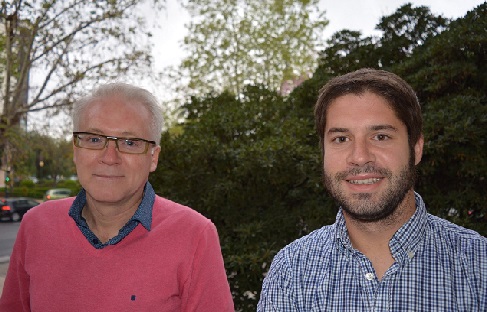
A study coordinated by the ERI BioTecMed (Interdisciplinary Research Structure for Biotechnology and Biomedicine) of the Universitat de València that has been published in the journal ‘Scientific Reports’ opens the way to the design of new membrane proteins and to the research of drugs to treat pathological processes in which receptors and transporters participate.
The importance of this work lays on the fact that biological membranes, formed by a double layer of lipids in which multitude of proteins that act as receptors, canals and transporters are found, represent the frontier between the cell and the rest of the universe. The passing of information and molecules from one side to the other of the membrane, a process that is inherent to all living beings, depends on the activity of the membrane integral proteins, and that is the reason why life is inconceivable without the existence of these proteins.
‘In fact, membrane proteins represent between the 20% and the 30% of the proteins of living beings and, furthermore, are the bullseye of approximately the 60% of the drugs that are currently on the market’, says Ismael Mingarro, full university professor of Biochemistry and Molecular Biology at the Universitat de València and coordinator of the work.
This research shows that the efficiency of the insertion of these proteins in the membrane depends on factors such as composition, the longitude or the position of specific amino acids inside the regions that cross the membrane.
Among the main conclusions of the study, scientists stand out that if it is taken into account not just proportions, but also the distribution of amino acid residues in the different positions inside the membrane ‘we can achieve the minimizing of the proteins size, which facilitates the usage in new biotechnology applications, and to make possible to insert sequences with “unfavourable” amino acids, but which carry out specific functions’, has explained Ismael Mingaror. ‘This is to say, to make possible for us to lay out to provide these proteins with new functions or to modulate the effect of drugs through rational designs’, he concludes.
The research that has led to the article ‘Biological insertion of computationally designed short transmembrane segments’, published in the journal Scientific Reports, has been developed by the Department of Biochemistry and Molecular Biology of the Stockholm University and the National Genomic Analysis Centre of Barcelona.
Additionally, the experts stand out the good interrelationship between the experimental insertion data and the predictions obtained with the computing algorithm used. ‘A way of improving even more this algorithm will be to add the possible interactions among amino acids, as well as the effect that has the presence of proline residues in this areas’, has pointed out Ismael Mingarro.
The main novelty that contributes to this research is that the starting information used has been obtained from a huge data base of membrane proteins which structure has been solved at an atomic level, unlike other studies in which the data base had significantly less proteins and could show bias or were based on predictions, not in real observations.
’In our case, the starting information comes from native proteins, which nature has selected through the evolution together with the lipid components that form the biologic membranes’. says Carlos Baez-Delgado, predoctorate researcher of the Universitat de València and first signatory of the article, who points out that another novelty of the work is ‘the structural confirmation of the parameters that rule the adoption of the adequate orientation of these proteins in biologic membranes’.
Research
The research was first designed at the laboratory of the Universitat de València, and for its fulfilment Marc Marti-Renom (from the National Genomic Analysis Centre-Genomic Regulation Centre) and Gunnar von Heijne (from the University of Stockholm) were chosen as collaborators.
In practise, the work has been carried out in two phases. In the first one, a computing statistic analysis of the sequences of the membrane proteins which structure has been resolved was carried out, specifically of the parts of the proteins inserted in the membrane. With the data obtained from this analyses there were computationally generated thousands of sequences with different longitude and composition of amino acids, buy keeping the proportions and distribution in position inside the membrane that are found in nature.
‘Right after- explains Ismael Mingarro- we calculate the theoric probability of insertion of these sequences using a prediction algorithm. In a second phase, it has been experimentally tested the insertion in the membrane of some of the generated sequences using approximations of biochemistry and molecular biology’.
Furthermore, the obtained results were validated in two different laboratories. This way, the data obtained in the Valencian laboratory (http://www.uv.es/membrana) were contrasted in the laboratory of the professor Gunnar von Heijne, at the University of Stockholm, through a research stay.
The research has had the collaboration of the Ministry of Economy and Competitiveness through Fondos FEDER; the PROMETEO programme of the Valencian Government; the Swedish Foundation for Strategic Research; or the European Research Council, among other entities.
Teaching and research trajectory
Carlos Baez is graduated in Biochemistry at the Universitat de València an he has been pre-doctorate grant holder of the Training of Research Staff programme (FPI) of the Ministry of Economy and Competitiveness in the group of Membrane Proteins (http://www.uv.es/membrana/). He has carried out research stays at the University of Stockholm and at the National Genomic Analysis Centre. Currently, he is writing his doctoral thesis.
Ismael Mingarro is full university professor of Molecular Biology and Biochemistry at the Universitat de València, where he directs the group of Membrane Proteins. His research is focused on the understanding of the biosynthesis and protein folding mechanisms in membrane environments. He teaches in the degree in Biochemistry and Biomedical Sciences and in the degree in Biotechnology.
Article:
Baeza-Delgado, C. et al. Biological insertion of computationally designed short transmembrane segments. Sci. Rep. 6, 23397; doi: 10.1038/srep23397 (2016).
Link: http://www.nature.com/articles/srep23397






























